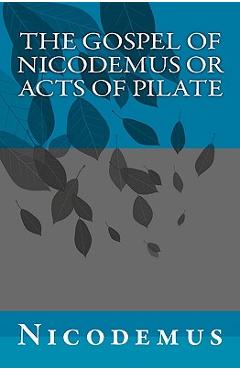The Gospel of Nicodemus and Christ\'s Descent into Hell: with footnotes and Latin text - Nicodemus

Detalii The Gospel of Nicodemus and
The Gospel of Nicodemus and - Disponibil la libris.ro
Pe YEO găsești The Gospel of Nicodemus and de la Nicodemus, în categoria Bibles.
Indiferent de nevoile tale, The Gospel of Nicodemus and Christ\'s Descent into Hell: with footnotes and Latin text - Nicodemus din categoria Bibles îți poate aduce un echilibru perfect între calitate și preț, cu avantaje practice și moderne.
Preț: 51.04 Lei
Caracteristicile produsului The Gospel of Nicodemus and
- Brand: Nicodemus
- Categoria: Bibles
- Magazin: libris.ro
- Ultima actualizare: 28-10-2025 01:22:05
Comandă The Gospel of Nicodemus and Online, Simplu și Rapid
Prin intermediul platformei YEO, poți comanda The Gospel of Nicodemus and de la libris.ro rapid și în siguranță. Bucură-te de o experiență de cumpărături online optimizată și descoperă cele mai bune oferte actualizate constant.
Descriere magazin:
The Gospel of Nicodemus, otherwise known as the Acts of Pilate (Acta Pilati) is not assumed to have written by Pilate, but rather to have been compiled from the official acts which were preserved in the praetorium at Jerusalem. The original is said to have been written by Nicodemus in Hebrew. The work gained a wide readership in the Middle Ages, with its popularity shown by the number of languages and versions in which it exists. Currently, there are known copies in Greek, Coptic, Armenian and Latin. These Acts are composed of three sections. The first section relates to the trial of Jesus and is similar to Luke 23. The second part regards the Resurrection. Then in the third part, Christ\'s Descent into Hell (Descensus ad Infernos), for which there is no known Greek text. In it, Leucius and Charinus, two souls who are raised from the dead after the Crucifixion tell the Sanhedrin the circumstances of the descent of Christ into Limbo. This short book gives the full Acts of Pilate along with footnotes to referring Bible passages and includes the Latin text of Descensus ad Infernos as an appendix. The source text for this work is Apocryphal Gospels, Acts, and Revelations (1870) by Alexander Walker (1825-1903).

Produse asemănătoare

The Gospel of Mark: A Beginner\'s Guide to the Good News - Amy-jill Levine
![]() libris.ro
libris.ro
Actualizat in 28/10/2025
105.97 Lei

The Gospel of John: Mirror Study Bible - Francois Du Toit
![]() libris.ro
libris.ro
Actualizat in 28/10/2025
111.6 Lei

Adorned: Living Out the Beauty of the Gospel Together - Nancy Demoss Wolgemuth
![]() libris.ro
libris.ro
Actualizat in 28/10/2025
94.81 Lei

The Gospel of the Red Man the Gospel of the Red Man: An Indian Bible an Indian Bible - Ernest Thompson Seton
![]() libris.ro
libris.ro
Actualizat in 28/10/2025
77.84 Lei

Rescuing the Gospel from the Cowboys: A Native American Expression of the Jesus Way - Richard Twiss
![]() libris.ro
libris.ro
Actualizat in 28/10/2025
150.61 Lei

Fire of Mercy, Heart of the Word: Meditations on the Gospel According to Saint Matthew - Erasmo Leiva Merikakis
![]() libris.ro
libris.ro
Actualizat in 28/10/2025
195.02 Lei
Produse marca Nicodemus

The Gospel of Nicodemus and Christ\'s Descent into Hell: with footnotes and Latin text - Nicodemus
![]() libris.ro
libris.ro
Actualizat in 28/10/2025
51.04 Lei
